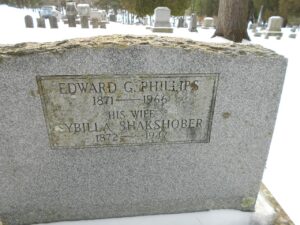 Many years beyond the lifetime of Sybilla Shakshober Phillips (1872-1947), I discovered a pocket-sized daybook in my grandmother’s living room cabinet, which turned out to be a Masonic almanac or “National Diary” registered in 1879 for the Year 1880. In pencil on the flyleaf was written: “Miss Sybilla Shakshober.” Several pages in the front and throughout the volume were removed and only a few pages had been used at all. One or more members of the family had sporadically used the book for household accounting before it fell into the hands of young Sybilla, who mimicked its adult style by recording her transactions.
For example, on the page dated February 6, 1880:
Many years beyond the lifetime of Sybilla Shakshober Phillips (1872-1947), I discovered a pocket-sized daybook in my grandmother’s living room cabinet, which turned out to be a Masonic almanac or “National Diary” registered in 1879 for the Year 1880. In pencil on the flyleaf was written: “Miss Sybilla Shakshober.” Several pages in the front and throughout the volume were removed and only a few pages had been used at all. One or more members of the family had sporadically used the book for household accounting before it fell into the hands of young Sybilla, who mimicked its adult style by recording her transactions.
For example, on the page dated February 6, 1880:
Sybilla
I sent off five sents for doll.
Sybilla Shakshober, youngest daughter of John and Anna, was born 10 August 1872, in Arlington, Bennington County, Vermont.[1] She was two years old when her father died on 18 February 1875,[2] of an unspecified but “long and painful illness.” His parting words are expressed in what is possibly the most histrionic death announcement I have ever seen:
The last conversation the deceased had with his wife, he said: “Wife, there is no use concealing the fact any longer; I shall have to die within a very few days; I have kept the fact within my own breast for a long time; now, you must prepare for the worst.”[3]
This newspaper item assured readers the widow and children would be provided for, yet in March 1878, John Shakshober’s estate administrator petitioned Bennington County Court to sell all of John’s real property for the payment of debts.[4] Widow Anna Shakshober and her children moved to the even more remote village of West Wardsboro, where they ran a farm that included sugar orchards. It was around this time that the daybook was printed.
[In] March 1878, John Shakshober’s estate administrator petitioned Bennington County Court to sell all of John’s real property for the payment of debts.
Sybilla did not begin writing in the book until she was about eleven years old and made only a few entries. The first is dated Saturday, February 11, 1880 [“0” crossed out and “4” written in pen]:
It has been snowing all day to day & it is Sunday Perhaps if it had not snowed Barb would have come home. i wish she had. It is awful dark out to night. [?] i wish it was spring. i guess that i will make up a story some day this week and Paint some i haven’t Painted in a good while. i don’t believe that i shall go to school any more this term. Now i guess that i will go to bed. i am Tired to night.
Barb was Sybilla’s oldest sister, a resident of Seymour, New Haven County, Connecticut, where she worked as a milliner. Though still legally married, she was in the middle of a protracted divorce with her husband, Theodore Gaul. Sybilla was aware of the Gaul’s marital strife, as Theodore had briefly lived with the Shakshobers after his marriage to Barbara.
One of Sybilla’s only other entries is this:
Monday, December 20, 1880 [sic]
Last night was Xmas and i went to the Xmas tree and had a Beautiful time and i stayed with Maude all night. And she came home with me this morning and rode home with Jake today.
Jake was Sybilla’s brother, age 16 in 1880. Other entries appear to have been made by one or more of Sybilla’s older sisters—Barbara (b. 1854), Mary (b. 1859), Carrie (b. 1863), or Anna (b. 1869), or possibly her mother. In purple ink, written in the Memoranda section:
May gave me that white dress of hers the one she graduated in wa[s]n[‘]t she good.
Saturday, Jan 17th, 79.
“May” is Sybilla’s sister Mary, age 19 in January 1879. She was a West Wardsboro schoolteacher and in a few years would attend the Northfield Seminary in Massachusetts to further her credentials. It is possible that fifteen-year-old Carrie was the author of this entry.
As a genealogical record, Sybilla’s daybook corroborates basic facts about the Shakshober family, like who was living at home around 1879/80. What did the seemingly mundane National Diary of 1880 mean to Sybilla? I could hardly blame her for flipping past the almanac, finding a blank page, and recording her thoughts in girlish penmanship. In addition to being a primer for handwriting and an outlet for her loneliness, the daybook was a space to play at being an adult, recording her activities, plans, and purchases.
Notes
[1] Vermont, Vital Records, 1720-1908; 1871 and later, Severy-Sheldon; image 848/4713 (Ancestry).
[2] “Deaths,” Manchester Journal, 25 February 1875, 2.
[3] “In Memoriam. Died.—In East Arlington, Feb 18, 1875, John Schackschober, Esq.,” Bennington Banner, 25 February 1875.
[4] The Manchester Journal, 14 March 1878, 2.
Share this:

About Jennifer Shakshober
Jen Shakshober earned a dual BA in English and Economics from Westfield State University, an MFA in Creative Nonfiction from Bennington College, and a certificate in Genealogical Research from Boston University. She is currently pursuing an MLIS in Archives Management from Simmons University. Her past research has involved nineteenth and twentieth-century Vermont records from local and state-level repositories. Most recently she wrote two articles about the murder of labor organizer Joseph Shoemaker for The Walloomsack Review, a biannual publication of the Bennington (Vt.) Museum, and she is always interested in crafting narrative genealogical reports.View all posts by Jennifer Shakshober →